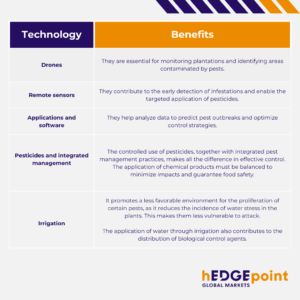What are the main agricultural pests of coffee?
Get to know the main agricultural pests of coffee. We explain how to combat them and highlight their impact on the production of the commodity.
Agricultural pests cause numerous problems in coffee plantations. In this sense, they can cause direct and indirect damage that affects production and the quality of the final product.
As such, they even contribute to volatility in the coffee market: lower productivity brings risks to the balance between supply and demand for the commodity. In Brazil, agricultural pests require extreme attention, after all, the country is the largest producer and exporter of coffee on the planet.
With this in mind, we have put together this exclusive piece of content in which you will understand:
- The main agricultural pests of coffee and their impacts.
- How technology helps to combat and prevent it.
- The importance of knowledge for producers to adopt the best risk management strategies.
Enjoy the reading!
What are the main agricultural pests of coffee?
Below, we explain in detail what the 5 main agricultural pests of coffee are. Check them out below!
● Coffee berry borer (Hypothenemus hampei)
Problems caused by the coffee berry borer have been reported in Brazil since the 1920s. It is a beetle that reaches the fruit of the commodity and reproduces inside it. After mating, the males remain inside the fruit. The females, in turn, leave to colonize new fruits.
For this reason, the main thing that leads to borer infestation is leaving fallen fruit on the crop. It is precisely through these that the borer multiplies and grows.
As a result, the larvae of this pest consume the coffee seeds and cause damage to the quality and quantity of the harvest. Regions with higher humidity and denser plantations have a higher risk of coffee berry borer development. Therefore, crops with rainy winters may suffer more attacks.
● Spider mite (Tetranychus urticae)
A mite that feeds on the leaves of the coffee plant and causes the leaves to turn yellow and fall off. Subsequently, these areas become necrotic and perforation occurs in the affected area. This considerably damages the overall health of the plant.
● Cicada (Empoasca spp.)
It is a sap-sucking insect that causes damage due to its bites, as it injects toxins into the attacked plants. This species causes physical damage due to the penetration of its stylet into the plant’s phloem.
The result? Disorganization and granulation of the cells, which obstructs the vessels that carry the sap. In addition, toxic substances are also injected during feeding.
In more serious cases, there is yellowing of the leaf margins and subsequent drying out of the structures, which can cause a reduction in the size of the plants. For coffee crops, the leafhopper leads to the development of diseases and has an impact on productivity.
● Mealybug (Planococcus citri)
It is a sap-sucking insect that feeds on coffee plants and causes direct damage by feeding on the sap of the branches, leaves and fruit. This results in a general weakening of the plants, a reduction in photosynthesis capacity and a decrease in coffee bean production.
In addition, the presence of mealybugs can encourage the development of harmful fungi such as fumagina, which feed on the insects’ sugary excrement. It is therefore an agricultural pest that further damages the health and yield of coffee plants.
● Coffee rust (Hemileia vastatrix)
Coffee leaf rust (Hemileia vastatrix) is a devastating fungal disease that severely affects coffee crops. This fungus develops on the leaves of coffee plants and forms yellowish spots that eventually turn into orange pustules.
These pustules contain spores that are easily spread by wind and rainwater. Rust then compromises the leaves’ ability to photosynthesize and leads to the following consequences:
- Premature leaf fall.
- Reduction in nutrient production.
- General weakening of the plant.
As a result, there is a significant decrease in bean production and coffee quality. The disease can spread rapidly under favorable humidity and temperature conditions and poses a constant threat to coffee plantations.
Understand the effects of agricultural pests on coffee growing
To help you understand how pests affect the coffee sector, we bring you the example of an event that affected producers in Central America and Colombia.
From 2009 to 2013, Central America and Colombia were affected by a significant outbreak of a specific pest: coffee rust (Hemileia vastatrix), which we mentioned earlier.
During this period, it caused extensive damage to coffee plantations in several Central American countries. These include Honduras, Guatemala, Costa Rica, El Salvador and Nicaragua, as well as Colombia.
The rapid spread of the rust was attributed to specific climatic conditions and the lack of adequate control measures. This outbreak had a significant impact on coffee production and resulted in crop losses.
Farmers had to implement control measures, such as applying fungicides. In addition, the situation highlighted the vulnerability of coffee plantations to disease and the need for more effective management and prevention strategies. After this period, several affected countries began planting new areas with varieties resistant to the disease.
Read more:
- Purchasing supplies: check out tips on how to plan
Technology: an ally in the fight against coffee pests
We talked above about the need to adopt advanced strategies for controlling coffee pests. Technology plays a central role in this.
In the table below, we explain each of the technological applications that help prevent and combat pests.

- Understand the importance of irrigation in agriculture 4.0
hEDGEpoint HUB: knowledge for coffee producers
As you’ve seen, it’s important for producers to know what can affect their coffee production. This is the case with agricultural pests, as they are capable of impacting the entire final revenue targeted.
It is therefore essential that producers adopt measures to prevent and combat the emergence of these pests. Knowledge in the area makes all the difference so that they can establish the best practices for their crop and also manage it.
The hEDGEpoint HUB exists precisely for the purpose of training those involved in the agricultural commodity risk management chain. With courses adapted to different levels of knowledge, this is hEDGEpoint‘s educational tool.
Here we combine courses and financial education with in-depth research, analysis and reports. All in one place to develop risk management in commodities.
Access the hEDGEpoint HUB now and try our platform for a 1-month free trial.






